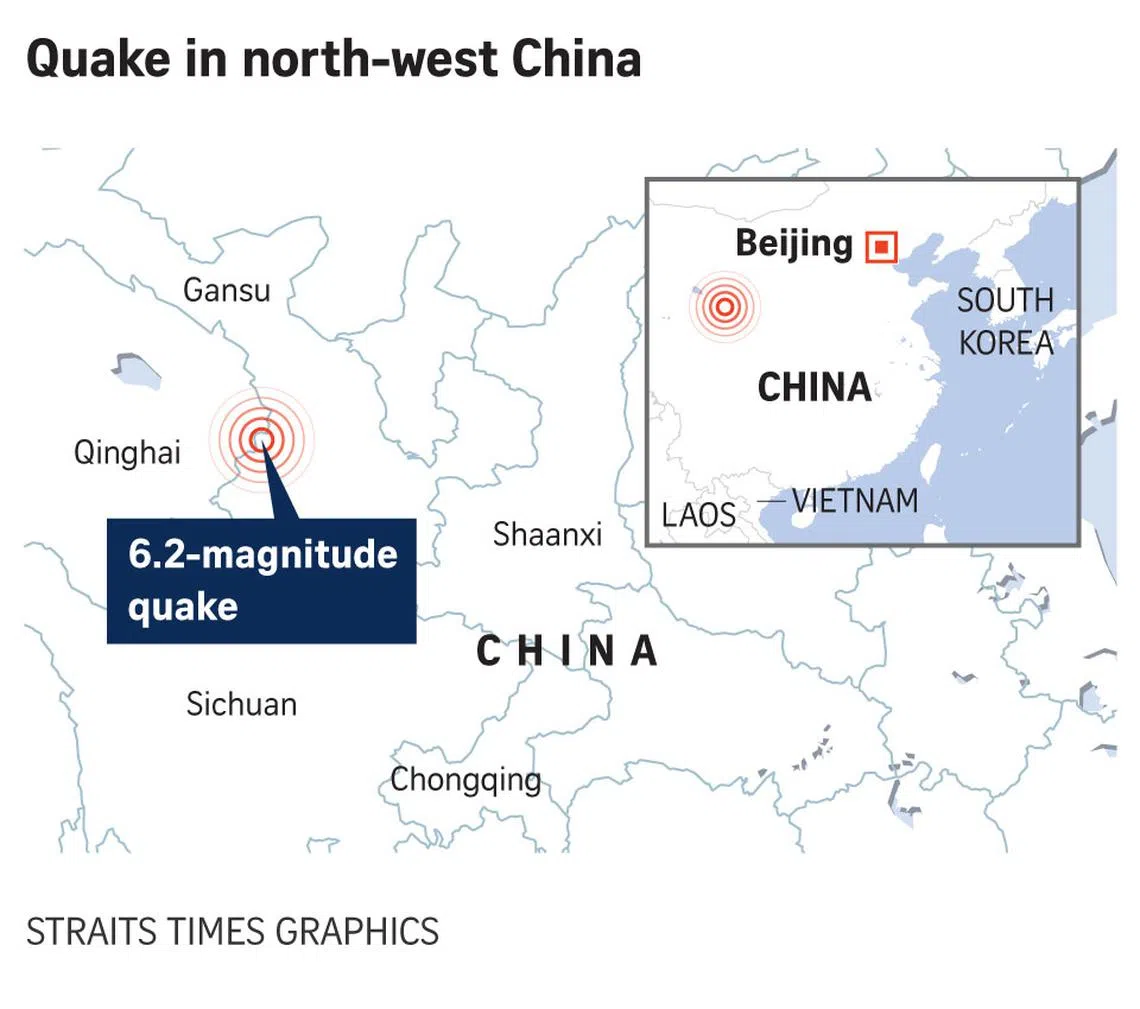Chinese earthquake victims pulled to safety in sub-freezing weather
Sign up now: Get ST's newsletters delivered to your inbox
Follow topic:
HAIDONG, Qinghai – Braving below-freezing conditions, rescuers pulled to safety victims of an earthquake that rocked a remote area in China’s north-western Gansu province more than a day ago, while survivors faced months of uncertainty ahead without permanent shelter.
The magnitude-6.2 earthquake jolted Jishishan
It damaged roads, power and water lines, and agricultural production facilities, as well as triggered landslides and mudslides.
In Gansu, 113 people had been found dead
The death toll in Qinghai province rose to 18, with 198 injured as at 5.30am on Dec 20.
Seventy-eight people have been found alive in Gansu, where rescue operations ended on the afternoon of Dec 19, state and local media said, as focus shifted to treating the wounded and resettling residents as a months-long winter loomed.
It was not immediately clear whether the search in Qinghai had ended or not.

In Gansu, more than 207,000 homes were wrecked and nearly 15,000 houses collapsed, affecting more than 145,000 people.
More than 128,000 emergency supply items, including tents, quilts, tent lights and folding beds, were delivered, while food such as steamed buns and instant noodles were provided to the victims, state television CCTV said.
The quake-stricken area is geographically a transition zone between two plateaus, featuring terrains of altitudes ranging from 1,800m to 4,300m with “very complex” topography, CCTV said.
Recovery from the Dec 18 earthquake has been further challenged by the powerful cold snap that has gripped most of China since last week. Temperatures around the quake epicentre in Gansu fell to about minus 15 deg C on the night of Dec 19.
According to local media citing researchers, people trapped under rubble exposed to minus 10 deg C conditions without help run the risk of developing hypothermia and may be able to live for only five to 10 hours if uninjured.
In Qinghai’s quake-hit Haidong, Mr Du Haiyi said his family home had been completely levelled.
The 21-year-old told Reuters he had managed to save his mother and 16-year-old sister, who were trapped under debris on the night of the quake.
“My parents were pulled out from underneath this, but I don’t know how,” Mr Du said. “We ran to wherever we could.”
Mr Du, an occasional labourer, said his family of seven had slept exposed to the elements with neither sustenance nor adequate cover, taking shelter in a tent provided by the local government.
Homeless in winter
Those who lost their homes in the earthquake on Dec 18 had few options but to gather in fields, burning wheat straw for warmth. One family of seven took refuge in a car for the night as emergency tents were prioritised for the elderly and young, Beijing Youth Daily reported.
Within 50km of the epicentre on the side of Qinghai province, the earthquake affected 22 towns and villages, but of those, two villages suffered the worst damage.
Qinghai’s Minhe county in the city of Haidong earlier recorded 20 missing people from two villages, where a mudslide swept through, half-burying many buildings in brown silt.
Search-and-rescue operations and efforts to resettle residents were complicated as mud blocked main roads, state media said, showing footage of bulldozers clawing through mud and rubble.
“We have prepared coats with extra cotton, like military coats, and then some things to keep warm like heating equipment,” said 21-year-old Wu Saying, a rescue volunteer in Haidong.
Food supplies were also a concern. “I didn’t have anything to eat yesterday, and today, I’m eating the food left in the house,” said 53-year-old Bao Yinzi. “The pot is buried, the bowl is buried. There’s nothing left.”
Wary of aftershocks
The freezing cold was not the only concern weighing on rescuers and working groups assessing the situation.
The Gansu Provincial Seismological Bureau said comprehensive analysis showed that strong aftershocks of magnitude-5.0 were still possible around the area in the coming days, based on the characteristics of the Dec 18 quake, historical seismic activity and other factors.
The aftershocks will be closely tracked so as to issue early warnings, official news agency Xinhua cited the bureau’s deputy director as saying.
Mr Wu, the volunteer, said villagers whose homes were seriously damaged were given tents. He said he was worried about aftershocks.
By early Dec 20, there were two aftershocks of magnitude-4.0 and above, and eight of magnitude-3.0 and above, the China Earthquake Networks Centre said.
The quake in Gansu’s Jishishan county was logged at a depth of 10km, which experts consider shallow.
Earthquakes with shallow focal points can easily cause considerable damage to the ground, Xinhua reported, citing a senior engineer at the China Seismological Network Centre.
Earthquakes are common in provinces such as Gansu, lying on the north-eastern boundary of the tectonically active Qinghai-Tibetan plateau.
China’s deadliest quake in recent decades was in 2008, when a magnitude-8.0 temblor struck Sichuan, killing nearly 70,000 people. REUTERS

